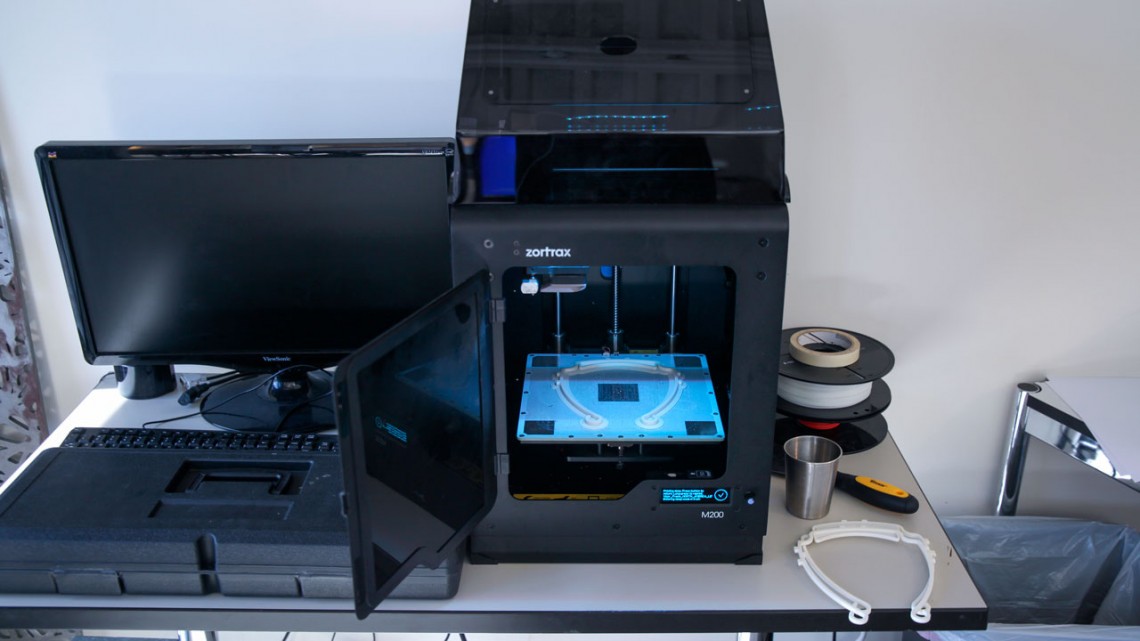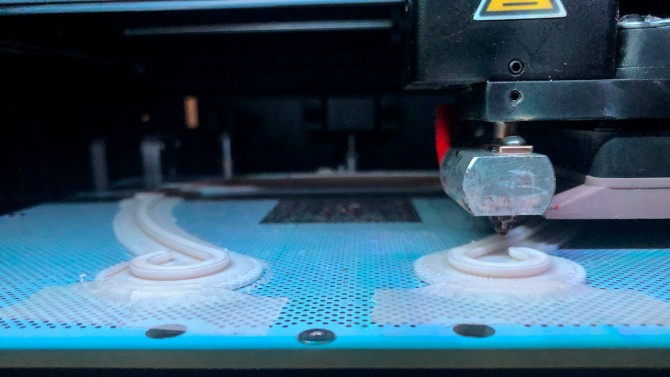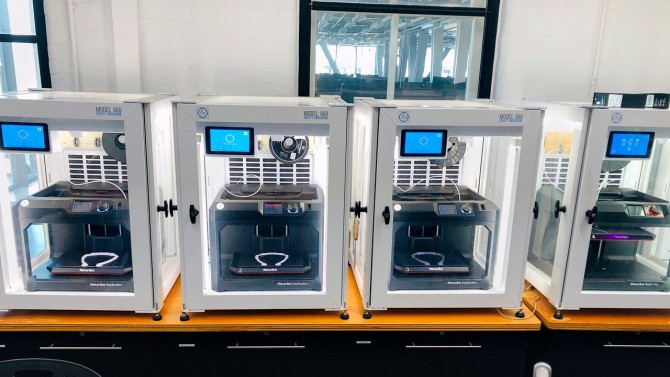
Protective visors for medical workers at Weill Cornell Medicine and local hospitals being 3D printed in labs at the College of Architecture, Art and Planning.
Cross-campus effort rushes 3D-printed gear to Weill Cornell
By Melanie Lefkowitz
Last week, concerned about a lack of protective gear for medical workers, Amy Kuceyeski, associate professor of mathematics at Weill Cornell Medicine’s Department of Radiology, thought about all the 3D printers on the Ithaca campus, sitting idle with students gone and nonessential research on pause.
“On Twitter I’d heard about how people are 3D printing face masks, so I decided to blast email all of the engineering department chairs to see if anybody knew of anybody who had printers or availability to print,” said Kuceyeski, who also leads an intercampus Machine Learning in Medicine initiative and has a laboratory on the Ithaca campus.
In a matter of hours, her request ricocheted across Cornell’s colleges and beyond. Deans helped faculty members and staff gain permission to access campus as essential personnel in order to activate 3D printers. Students and faculty who’d brought home 3D printers fired them up in their basements and kept them churning overnight. The community – including alumni, members of Ithaca Generator and other Ithaca residents – pitched in, too.
Now the effort is producing an estimated 400 visors a day, and the Cornell Campus-to-Campus bus made a special trip to deliver the first shipment March 27.
“It’s a drop in the bucket, unfortunately, but it’s at least a drop,” said Kuceyeski, adding that these masks are an important way to buttress supplies for Weill Cornell Medicine and NewYork-Presbyterian. “I’ve been completely overwhelmed with the response of people volunteering their materials and their time and expertise.”
Visors and other protective gear are also being provided to Ithaca-area health care workers, including at Cayuga Medical Center. Scientists at Cornell AgriTech in Geneva, New York, have already produced 200 face shields for local medical workers using 3D printers.
Kirstin Petersen, assistant professor of electrical and computer engineering, was forwarded Kuceyeski’s email by her department chair.
“She asked whether this was doable, and my partner (Nils Napp, assistant professor of electrical and computer engineering) and I reached out to everyone we knew, and they reached out to everyone they knew, and the ball got rolling,” Petersen said. “People want to do anything they can, and everyone’s been sitting on their hands for so long, so when there was an organized call for help everybody jumped in.”
Using Weill Cornell Medicine’s specifications, faculty, staff, students, alumni and community members are 3D printing frames for face visors, ideally with PET or PETG (polyethylene terephthalate, or polyethylene terephthalate glycol-modified) filament, which can be sterilized under ultraviolet light. Those with laser cutters are also producing shields for the visors, said Jenny Sabin, the Arthur L. and Isabel B. Wiesenberger Professor in Architecture and associate dean for design initiatives at the College of Architecture, Art and Planning.
“With the support of Dean Meejin Yoon and our director of facilities, Frank Parish, we were able to immediately get our digital fabrication labs up and running at AAP,” Sabin said. “I’m operating machines in my lab; our students with 3D printers at home are printing and shipping visors directly to Weill Cornell Medicine; we have alumni architects with offices in New York City utilizing their 3D printers and reaching out to their networks. I’ve been in constant communication with a whole incredible outpouring of people willing to help.”
In fewer than three days, she said, the effort grew from two labs printing at AAP into a network of faculty, staff, students, alumni and other institutions and architecture departments across the country.
Printers are also cranking out masks at the College of Human Ecology, Cornell Tech, Cornell University Library, and Computing and Information Science. François Guimbretière, professor of information science, is putting several 3D printers used by his Information Science Introduction to Rapid Prototyping and Physical Computing class to work, both in his own home and in the homes of his students. “It’s very nice that we can use these resources to support the community,” he said.
In addition to offering to 3D print visors, community members have volunteered to help organize or deliver equipment. While the fabrication is fairly easy for anyone with a basic knowledge of 3D printing, organizers said it’s essential that volunteers stick exactly to Weill Cornell Medicine’s instructions. (The visors’ parts are sterilized and assembled at Weill Cornell Medicine.)
“We’re in a city of designers, and my biggest job right now is trying to keep people from redesigning these parts to optimize them – people at Weill Cornell Medicine do not have the capacity right now to test out different parts,” Petersen said. “The important thing is to just keep the printers going as fast as possible: 3D printing is probably the slowest possible method of making these parts, but we don’t have anything else set up right now.”
Anyone interested in helping with the 3D-printing effort can contact Petersen at kirstin@cornell.edu, Kuceyeski at amk2012@med.cornell.edu or Sabin at jsabin@cornell.edu. There’s also a need for transparencies to make shields for the local medical community; anyone with supplies to donate should contact Petersen.
Media Contact
Get Cornell news delivered right to your inbox.
Subscribe


